TAMEST Natural Hazards Summit Looks at Impacts and Mitigating Effects
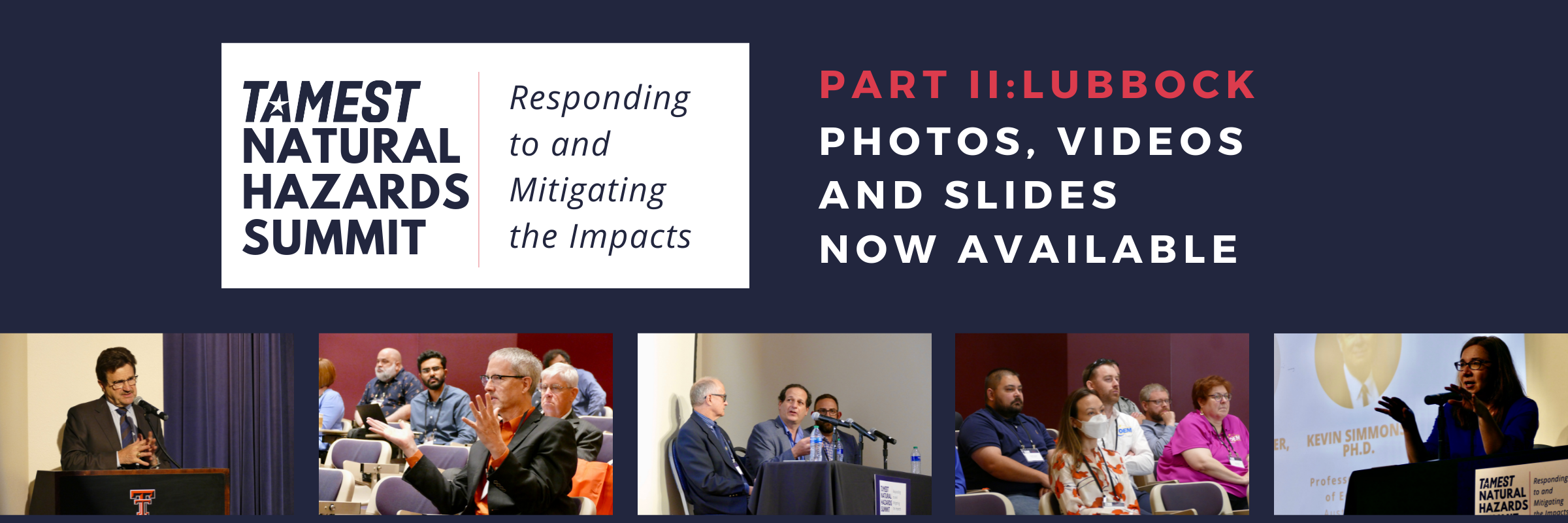
The TAMEST Natural Hazards Summit: Responding to and Mitigating the Impacts held Part II of its two-part series on Monday, May 16, presented by Texas Tech University’s National Wind Institute.
Nearly 75 experts convened from across the United States and Canada at Texas Tech’s International Cultural Center in Lubbock, Texas for the discussions. The summit examined natural hazards’ warnings, response, and engineering aspects, with a focus on tornadoes, thunderstorms, drought and hail.
The program looked at what the state needs to know and do to prepare for future natural disasters, unprecedented weather events and global pandemics, including response, recovery and mitigation of the impacts. Both attendees and speakers at the summit brought fresh perspectives to natural hazards prevention and management from across the fields of government, research, health care and insurance.
“We have improved in technology related to tornado tracking, to collecting data in the field and to implementation in the field,” said Summit Co-Chair Kishor Mehta, Ph.D. (NAE) P. W. Horn Professor of Civil, Environmental and Construction Engineering, Texas Tech University. “At the same time, we still have a long way to go in terms of implementing the things that we have learned while also dealing with human behavior. Human behavior is an area we really need to focus on moving forward.”
Videos and slides from the summit can be found on our website.
Read our high-level takeaways below:
Theme 1: Prediction and Warning for Tornadoes
Plenary Speaker Kelvin K. Droegemeier, Ph.D., Regents’ Professor of Meteorology, University of Oklahoma
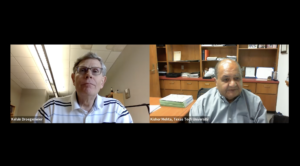 Dr. Droegemeier discussed the history of forecasting technology and why the FACETs comparison method is more reliable for tracking tornados than previous methods. The method narrows the scope of who is at most immediate risk during severe weather with new grid tracking technology that is constantly updated and more thoughtful regarding human behavior. He also stressed integrating social, behavioral and physical sciences in natural hazards mitigation research, citing it is crucial to the future of reporting. Dr. Droegemier mentioned artificial intelligence and quantum computing as two areas that will be transformative for tornado mitigation.
Dr. Droegemeier discussed the history of forecasting technology and why the FACETs comparison method is more reliable for tracking tornados than previous methods. The method narrows the scope of who is at most immediate risk during severe weather with new grid tracking technology that is constantly updated and more thoughtful regarding human behavior. He also stressed integrating social, behavioral and physical sciences in natural hazards mitigation research, citing it is crucial to the future of reporting. Dr. Droegemier mentioned artificial intelligence and quantum computing as two areas that will be transformative for tornado mitigation.
Biggest Takeaway:
“You can image people getting alerts on their cell phones to tell them how far they are away from the threat, what the probability is and maybe even where the closest shelter is and what action they ought to take. We can get much more sophisticated with the capabilities and technologies we have today while also understanding human behavior.” – Kelvin K. Droegemeier, Ph.D., University of Oklahoma
Panel: Climate Change, Drought and Economics of Warning
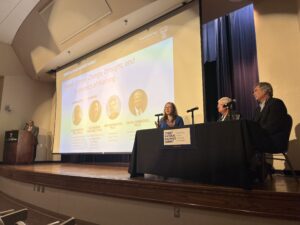 Moderator: Kishor Mehta Ph.D. (NAE), P. W. Horn Professor of Civil, Environmental and Construction Engineering, Texas Tech University
Moderator: Kishor Mehta Ph.D. (NAE), P. W. Horn Professor of Civil, Environmental and Construction Engineering, Texas Tech University
Panelists:
- Katharine Hayhoe, Ph.D., Paul Whitfield Horn Distinguished Professor and Political Science Endowed Chair in Public Policy and Public Law, Texas Tech University
- Ken Rainwater, Ph.D., Professor, Texas Tech University
- Kevin Simmons, Ph.D., Professor Emeritus of Economics, Austin College
The panel discussed the increased risk of disasters in Texas due to climate change as the population grows at rapid rates. In addition to the hazards themselves, the group agreed that disasters are also a function of exposure and vulnerability. The panel mentioned the need to ensure both people and infrastructure are prepared for future weather events. Drought planning was also brought up in Texas as an example, with the need to implement long-term planning to encourage conservation and develop alternative plans for water supplies. They also discussed human behavior and the importance of driving home accurate risk levels to the public so they are taken seriously.
Biggest Takeaways:
“We’ve been systematically underestimating the long-term changes, while overestimating the short-term, day-to-day. We often cry alarms that ended up not being quite as bad as we were afraid that they would be.” – Katherine Hayhoe, Ph.D., Texas Tech University, on the need to better report threat levels to the public.
Theme 2: Emergency Response and Recovery
Plenary Speaker Tracy Kijewski-Correa, Ph.D., Linbeck Chair and Associate Professor, College of Engineering & Keough School of Global Affairs, University of Notre Dame
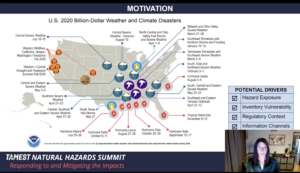 Dr. Kijewski-Correa discussed the record-setting losses related to weather and climate disasters we’ve experienced in recent years. To combat the rising costs of these events, Dr. Kijewski-Correa addressed the need to understand what drives changes in weather events to better understand how to plan for the true cost of rebuilding. More so, she discussed how the vulnerability of building inventory and infrastructure in this country contributes to economic losses. As a solution, she questioned current building regulations and discussed the need to realign our incentive structures for building and prevention to mitigate future risks better.
Dr. Kijewski-Correa discussed the record-setting losses related to weather and climate disasters we’ve experienced in recent years. To combat the rising costs of these events, Dr. Kijewski-Correa addressed the need to understand what drives changes in weather events to better understand how to plan for the true cost of rebuilding. More so, she discussed how the vulnerability of building inventory and infrastructure in this country contributes to economic losses. As a solution, she questioned current building regulations and discussed the need to realign our incentive structures for building and prevention to mitigate future risks better.
Biggest Takeaway:
“These events are tragic, but they are an important time to learn. Learning begins by going out into the field and observing in the real world the effects of these events on our communities … we need to find ways through partnerships and our direct involvement to move the information we learn back to impacted communities in time for them to build back better.” – Tracy Kijewski-Correa, Ph.D., University of Notre Dame
Panel: National Policies of Emergency Response: Trauma, Health Facilities and Case Study
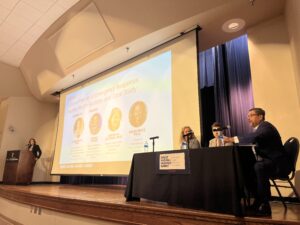 Moderator: Hanadi S. Rifai, Ph.D., Professor, University of Houston
Moderator: Hanadi S. Rifai, Ph.D., Professor, University of Houston
Panelists:
- Moises Dugan, Region 6 Deputy Administrator, Federal Emergency Management Agency (FEMA)
- Andrea M. Jackman, Ph.D., Senior Consultant in Data & Risk Sciences, ABS Group, Inc.
- Karin Price, Ph.D., Chief of Psychology, Texas Children’s Hospital
The panel discussed how we measure emergency response nationally and what current metrics can help foster resilience and promote recovery after storms. The panel looked at emergency response impacts and FEMA’s Emergency Management Cycle. The cycle aims to help reduce loss of life and property, prepare individuals to respond quickly to an event, save lives and property during an event, and help put a community back together after a disaster strikes. In addition to property damage and loss of life, the panel also discussed mental health impacts on individuals and children associated with natural disasters (immediate and longer-term risks).
Improved outcomes for the future include:
- Increasing access to evidence-based mental health interventions.
- Increasing support for healthy coping.
- Investment in school infrastructure and remediation efforts.
- Building community resilience and more.
Biggest Takeaway
“If we don’t measure ourselves, and if we don’t apply some type of quantitative aspect to our processes that we’ve set up … we’re letting somebody dictate that narrative for us.” – Andrea M. Jackman, Ph.D., ABS Group Inc.
Theme 3: Long-term Consideration: Risk and Mitigation
Plenary Speaker: Jamie Brown Kruse, Ph.D., Professor, East Carolina University
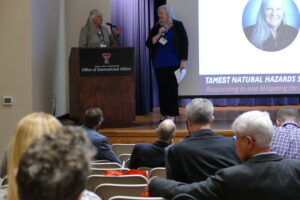 Dr. Kruse spoke on resilience management and the need for issue-driven research that captures the scope of disruption and recognizes the interdependence built within social, health and economic ecosystems. She discussed the need for research that can address the dynamic state of communities and their changes in risk and resilience over time. According to Dr. Kruse, ideal metrics for future natural hazards recovery data include information on the stability of a community’s population, economy, physical services, social services and government when determining future risk and recovery.
Dr. Kruse spoke on resilience management and the need for issue-driven research that captures the scope of disruption and recognizes the interdependence built within social, health and economic ecosystems. She discussed the need for research that can address the dynamic state of communities and their changes in risk and resilience over time. According to Dr. Kruse, ideal metrics for future natural hazards recovery data include information on the stability of a community’s population, economy, physical services, social services and government when determining future risk and recovery.
Biggest Takeaway:
“The system should be able to withstand and recover rapidly from disruptive events,” – Jamie Brown Kruse, Ph.D., East Caroline University
Panel: Improving Resiliency of Infrastructure to Prevent Fatalities and Mitigate Damages
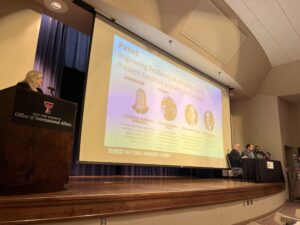 Moderator: Chandra Franklin Womack, P.E., Owner and Chief Executive Officer, Aran & Franklin Engineering, Inc.
Moderator: Chandra Franklin Womack, P.E., Owner and Chief Executive Officer, Aran & Franklin Engineering, Inc.
Panelists:
- Ian Giammanco, Ph.D., Lead Research Meteorologist & Sr. Director for Standards and Data Analytics, Insurance Institute for Business & Home Safety
- Chris Letchford, D.Phil., Professor and Chair, Rensselaer Polytechnic Institute
- Marc Levitan, Ph.D., Lead Research Engineer, National Windstorm Impact Reduction Program, National Institute of Standards and Technology
The final panel discussed hurdles to the accountability of building resilient infrastructure and how to keep companies honest in creating products that will withstand hazardous threats. They discussed the need to address all hazards a home or business faces when planning infrastructure and building, including hail, wind, tornadoes, lightning, etc. While large-scale disasters happen but are extremely rare, more minor hazards are becoming more common. Especially in metro areas, where buildings are larger and closer together than ever before, the cost of several smaller-scale events can quickly outpace more significant disasters.
Biggest Takeaway:
“We’re designing for the most commons tornadoes, not the most intense,” – Marc Levitan, Ph.D., National Institute of Standards and Technology
Open House and Tour of Texas Tech University’s National Wind Institute
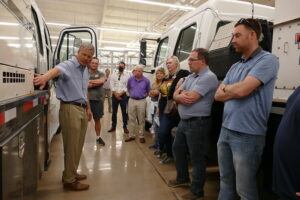 In addition to the summit itself, TAMEST also offered registrants an open house and tour of the National Wind Institute’s Reese Technology Center on Sunday, May 15, 2022. The tour was led by NWI’s Senior Director John Schroeder, Ph.D., Texas Tech University, who showcased demonstrations of NWI’s VorTECH tornado simulator, Debris Impact Facility, Ka-band radar station, wind tunnels, radar tracking mobility trucks and more.
In addition to the summit itself, TAMEST also offered registrants an open house and tour of the National Wind Institute’s Reese Technology Center on Sunday, May 15, 2022. The tour was led by NWI’s Senior Director John Schroeder, Ph.D., Texas Tech University, who showcased demonstrations of NWI’s VorTECH tornado simulator, Debris Impact Facility, Ka-band radar station, wind tunnels, radar tracking mobility trucks and more.
View photo highlights from the tour and networking reception.
Part I of the Summit took place virtually on October 19, 2021, via Zoom. The session was presented by the Hurricane Resilience Research Institute (HuRRI) at the University of Houston. Watch the videos.

